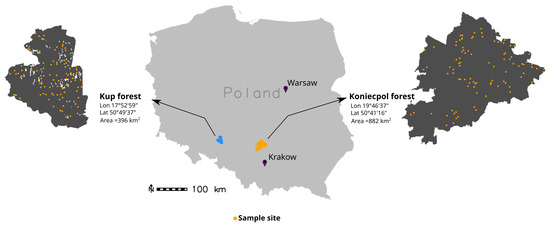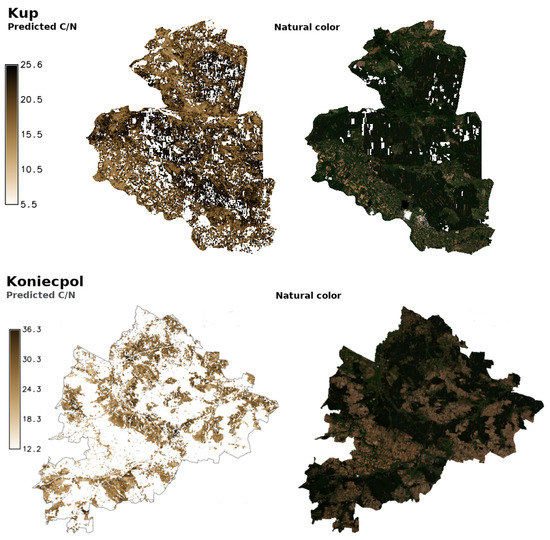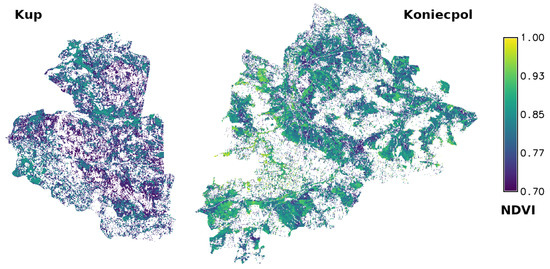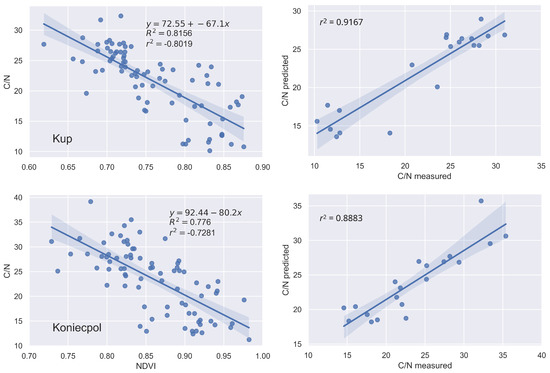Abstract
Forests are key ecosystems for climate change mitigation, playing a pivotal role in C and N land sequestering and storage. However, the sustainable management of forests is challenging for foresters who need continuous and reliable information on the status of soil conditions. Yet, the monitoring of soils in temperate evergreen forests, via satellite data, is jeopardized by the year round prevailing heavily dense canopy. In this study, the Sentinel-2 spectral imagery derived normalized difference vegetation index (NDVI), proved to be a reliable tool to determine the C/N ratio in two managed pine-dominated forests, in southern Poland. Results showed a strong negative correlation between NDVI values and the on-site C/N ratios measured at the upper soil horizons in 100 and 99 randomly distributed sampling points across the Kup (r = −0.8019) and Koniecpol (r = −0.7281) forests. This indicates the feasibility of using the NDVI to predict the microbial driven soil C/N ratio in evergreen forests, and to foresee alterations in the vegetation patterns elicited by microbial hindering soil abiotic or biotic factors. Spatial/temporal variations in C/N ratio also provide information on C and N soil dynamics and land ecosystem function in a changing climate.
1. Introduction
Coniferous temperate evergreen forests are key ecosystems for climate change mitigation, as they play a major role in carbon (C) and nitrogen (N) soil sequestration and storage [1,2]. Among soil properties, the C/N ratio is pivotal to soil biology and soil microbe community composition across soil types and climate zones [3]. The C-enriched root exudates in the rhizosphere of evergreen woody species are known to stimulate microbial N mineralization, thus maintaining the microbial C/N stoichiometric balance, via alterations in the microbiota taxonomic structure [4]. In forest ecosystems, the microbial necromass contributes to approximately 35% of the soil organic C content in the upper soil horizons [5,6]. While, soil and microbial N status plays a central role in the heterotrophic nitrifying activities, via the activity of soil N-fixing bacteria [7,8,9]. The uppermost soil horizons are also known to harbor a greatest bacterial diversity and fungal biomass, when compared to deepest horizons, involved in important biogeochemical processes such as the degradation of soluble carbohydrates and polysaccharides, as well as the metabolism of C-compounds [10,11]. Under coniferous trees, the upper soil horizon also plays a critical role in organic C storage [2,12], although its sensitivity to climate change rising temperatures might transform its storage capacity into a net source of CO [13].
In the case of managed evergreen pine forests, the maintenance of ecosystem resilience is crucial under climate change at multiple scales [10], as soil biology is directly modulated by the addition of synthetic fertilizers and the intensity of seasonal tree felling and replanting. As previously shown, intensive timber harvesting is known to hamper the soil C-sink capacity, concomitantly increasing the soil CO and CH emissions to the atmosphere [14]. Nevertheless, the sustainable forest-management is challenging for foresters who need continuous and reliable information on the status of soil conditions, since: (a) continuous on-site determinations of the soil C/N ratio across large forest sites is a laborious and time-consuming process, and (b) the monitoring via satellite data of soil properties in temperate evergreen forests, is jeopardized by the year-round dense canopy [15].
The normalized difference vegetation index (NDVI) selected for this study has been previously determined to be relevant for: (i) dendrochronological studies in boreal forests [16], (ii) the analyses of the degradation or loss of vigor of Romanian forests [17], (iii) the determination of the impact of anthropogenic activities on the aboveground biomass C dynamics [18], and (iv) significant improvements in forest conservation and sustainability [19], owing to the well-documented intimate relationships between soil biology and plant growth [20]. At the same time, freely available temporal, spatial, and spectral Sentinel-2 imagery has been successfully used for monitoring the impact of seasonal drought events on forest health [21,22], allowing a better sustainable management in terms of plantation inputs and production cost optimization [23,24]. Thus, the aim of this research was to test a new approach to address the use of Sentinel-2 imagery to estimate the soil microbial driven C/N ratios in the Kup and Koniecpol Forest districts of southern Poland, both of them known to be drought-prone [25].
2. Materials and Methods
2.1. Description of Forest Sites
This research was conducted in randomly scattered 100 sampling points across the Kup forest district (50°49′37″ N, 17°52′59″ E), and 99 sampling points across Koniecpol forest district (50°41′16″ N, 19°46′16″ E) in southern Poland (Figure 1). Both forests have a similar history of stands, growing season (212–215 days), accumulated annual precipitation (629–635 mm), average mean annual temperature (7.8–8.5 C), soils developed from fluvioglacial sand, clay, and peat sediments, as well as a flat topography dominated by Pinus sylvestris L. The negligible differences between the Kup and Koniecpol forests in terms of stands, and edaphoclimatic prevailing conditions allowed: (a) the doubling of the studied area, without the side effect of varying soil and climatic parameters; and (b) the assumption of an uniform pine needles litter fall, undergoing similar decomposition rates [26] carried out by a decomposer microbial community displaying many redundant functions [27], modulated by a dominant plant species [28].

Figure 1.
The sampling locations are marked with points. The two study sites are overlaid on the Poland map. The Kup (left) and Koniecpol (right) forest districts are highlighted.
2.2. Soil C and N Contents
At each sampling point in both forests, soils were collected up to a depth of 20 cm, during the summer of 2019. Soils were cleaned of stones and plant debris to be transported to the soil analytical laboratory at the University of Agriculture in Krakow. The total soil C and total N contents were determined in air dried subsamples sieved through a 2-mm mesh, using a LECO CNS True Mac Analyzer (Leco, St. Joseph, MI, USA). Average total C and N values were: (a) 25.92 ± 14.92% and 1.11 ± 0.57% in the Kup forest, and (b) 29.20 ± 15.65% and 1.22 ± 0.68% in the Koniecpol forest. The C and N values for each sampling point were used to calculate the C/N ratios.
2.3. Sentinel-2 Imagery and Vegetation Indices
Cloud-free Sentinel-2 imagery, taken at the same dates of the soil collection in individual sampling points at each forest site, were downloaded from the Copernicus Open Access Hub, as a Level-2A bottom-of-atmosphere. The normalized difference vegetation index (NDVI) was calculated using the near-infrared (NIR) and red edge (RED) reflectances, corresponding to the B05 and B08 bands in Sentinel-2 imagery, respectively (Table 1), both having 10 × 10 m spatial resolution, following the standard equation:

Table 1.
Sentinel-2 band parameters.
The raster maps obtained were masked using a vector file with the boundary of the Kup and Koniecpol forest districts. The Pearson correlation (r) was used to analyze linear correlations between the Sentinel-2 imagery derived NDVI and the on-site measured C/N ratio, at a significant level of 95%. The data set was divided into two subsets by a pseudo-random approach, one for the model calibration and the other for validation with a proportion of 80% and 20%, respectively. This approach facilitates the replication of the results. For Kup forest, the training subset was n = 80, and the validation subset was n = 20. For the Koniecpol forest, the data in each subset were 79 and 20, respectively. A linear regression was performed based on the determined NDVI values and soil C/N ratios. After obtaining the linear models, the soil C/N ratio maps were created from the NDVI maps and compared with a natural color composition for each forest area (Figure 2). The bare soil, urban zones and other non-vegetated areas were left off in these maps.

Figure 2.
Predicted C/N ratio and natural colour composition for comparing the forest areas.
3. Results
On-site analyses revealed non-significant differences in soil C/N ratios or NDVI values between both forests (Table 2), even though the statistical mean, minimum, and Q3 soil C/N as well as NVDI values were relatively higher in Koniecpol when compared to those in the Kup forest. The coefficients obtained from the regression model allowed the construction of an NDVI map linked to the soil C/N ratio map for the two forests. In Figure 3, geographical zones colored in yellow had higher NDVI values. The model performance was evaluated with the validation subset, obtaining the coefficient of determination for Kup forest (R = 0.8156) and Koniecpol forest (R = 0.7760) (Figure 4). The residuals assumptions were met in both models, with normality D’Agostino and Pearson’s test (p < 0.05) of 0.8087 and 0.8706 for Kup and Koniecpol forests, respectively.

Table 2.
Soil C/N ratio and Sentinel-2 derived Normalized Difference Vegetation Index (NDVI) determined in 100 sampling points in the Kup forest district and 99 sampling points in the Koniecpol forest district, in Southern Poland.

Figure 3.
Calculated NDVI for the Kup (left) and Koniecpol (right) forest districts.

Figure 4.
Regression analysis for the Kup (top) and Koniecpol (bottom) forest districts. The plots on the left show the measured C/N ratio, while the plots on the right show the predicted C/N.
4. Discussion
Worldwide, the Sentinel-2 imagery derived NDVI is the most commonly used vegetation index showing the strongest relationship with a large number of driving factors of vegetation changes [9]. The NDVI ranking between 0.6188 and 0.9823, could be considered as an indicator of the good plant-soil interactive conditions in both forest districts [29,30]. On the other hand, the soil C/N ratio is tightly associated with plant nutrient acquisition through various strategies such as forming mutualistic associations with N-fixing rhizobacteria and arbuscular mycorrhizal fungi, or the stimulus of soil microbial activity to mobilize nutrients from soil organic matter through root exudates [31,32,33]. It is interesting to note the significant positive correlation previously recorded between the C/N ratio and the activity of the prokaryote-excreted -glucosidase enzyme directly involved in the C cycle [34] in soils of the Manowo Forest District, northern Poland [35]. In the present study, the soil C/N ratios ranged between 10 and 32 in both forests, coinciding with values reported for forests dominated by non N-fixing tree species [36].
Most important is the strong negative correlation detected between the Sentinel-2 imagery-derived NDVI and the on-site determined soil C/N ratios, confirming the value of this vegetation index as an indicator of the biological properties of the upper soil horizons in temperate evergreen southern Poland’s forests. This observation was further supported by the intimate relationship existing between soil nutritional levels and NDVI in vegetated areas [37,38,39]. According to Li et al. [40], NDVI values could replace field soil investigations, so facilitating the large-scale monitoring of soil quality after land consolidation. Moreover, the average soil C/N ratios above 21 recorded in both forests strongly suggests the need to minimize losses of soil-bioavailable N, which are known to limit soil C-sink activity, thus simultaneously constraining net primary productivity as well as the capacity for forests to respond dynamically to disturbance and environmental changes [41]. Whereas, soil C/N ratios >30 should alert foresters on the possibility of increasing soil NO emissions toward the atmosphere [42].
5. Conclusions
The present study indicates the feasibility of using Sentinel-2 spectral imagery to infer, in real time, soil biology status across large forest areas, based on the strong negative correlation between the on-site measured soil C/N ratio and NDVI values, at both forest sites. The high accuracy obtained with this approach supports the use of Sentinel-2-derived NDVI to predict the long term hindering effects of drought, snow melting temperatures, seasonal fires, pests and plant diseases, as well as the over felling of trees on soil dynamics and the sustainability of the forest ecosystem. This new approach for estimating the soil C/N ratio under coniferous evergreen trees can provide reliable information on the soil status for the decision-making process underlying the sustainable management of the forest. However, more research is needed to validate the effectiveness of NVDI as an indicator of soil C/N ratio under soil and environmental conditions different to those prevailing in Poland’s Kup and Koniecpol forests.
Author Contributions
L.R., M.L.I.-M., J.L., L.R.-B. and E.B. Conceptualization, Formal Analysis, Writing—Original Draft Preparation, Writing—Review; E.C.V.-P. and L.V.-M. editing, validation, and visualization. All authors have read and agreed to the published version of the manuscript.
Funding
This research received no external funding.
Data Availability Statement
Not applicable.
Acknowledgments
The authors thank the State Forest Administration in Katowice for sharing results and its support in the research project. This study was supported by the Ministry of Science and Higher Education of the Republic of Poland, in the frame of subvention funds for the Faculty of Forestry, University of Agriculture, in Krakow. The authors also thank the Erasmus+ program and Rafael Herrera (forest ecologist, Ecology Center, Venezuelan Scientific Research Institute) for his enlightening comments and his English language revision of the manuscript.
Conflicts of Interest
The authors declare no conflict of interest.
References
- Petersson, H.; Ellison, D.; Mensah, A.A.; Berndes, G.; Egnell, G.; Lundblad, M.; Lundmark, T.; Lundström, A.; Stendahl, J.; Wikberg, P.-E. On the role of forests and the forest sector for climate change mitigation in sweden. Glob. Chang. Biol. Bioenergy 2022, 14, 793–813. [Google Scholar] [CrossRef]
- Hüblová, L.; Frouz, J. Contrasting effect of coniferous and broadleaf trees on soil carbon storage during reforestation of forest soils and afforestation of agricultural and post-mining soils. J. Environ. Manag. 2021, 290, 112567. [Google Scholar] [CrossRef] [PubMed]
- Xu, Z.; Zhang, T.; Wang, S.; Wang, Z. Soil ph and C/N ratio determines spatial variations in soil microbial communities and enzymatic activities of the agricultural ecosystems in northeast china: Jilin province case. Appl. Soil Ecol. 2020, 155, 103629. [Google Scholar] [CrossRef]
- Sun, L.; Ataka, M.; Kominami, Y.; Yoshimura, K.; Kitayama, K. A constant microbial C/N ratio mediates the microbial nitrogen mineralization induced by root exudation among four co-existing canopy species. Rhizosphere 2021, 17, 100317. [Google Scholar] [CrossRef]
- Karhu, K.; Alaei, S.; Li, J.; Merilä, P.; Ostonen, I.; Bengtson, P. Microbial carbon use efficiency and priming of soil organic matter mineralization by glucose additions in boreal forest soils with different C:N ratios. Soil Biol. Biochem. 2022, 167, 108615. [Google Scholar] [CrossRef]
- Deng, F.; Liang, C. Revisiting the quantitative contribution of microbial necromass to soil carbon pool: Stoichiometric control by microbes and soil. Soil Biol. Biochem. 2022, 165, 108486. [Google Scholar] [CrossRef]
- Cui, J.; Zhu, R.; Wang, X.; Xu, X.; Ai, C.; He, P.; Liang, G.; Zhou, W.; Zhu, P. Effect of high soil C/N ratio and nitrogen limitation caused by the long-term combined organic-inorganic fertilization on the soil microbial community structure and its dominated SOC decomposition. J. Environ. Manag. 2022, 303, 114155. [Google Scholar] [CrossRef]
- Chalk, P.M.; Lam, S.K.; Chen, D. The significance of endophytic and phyllospheric N2 fixation in forest trees: Evidence from stable (15n) and radioactive (13n) tracer studies. Trees (Berl. West) 2022, 36, 1179–1184. [Google Scholar] [CrossRef]
- Gao, W.; Chen, M.; Xu, X. Tracing controls of autotrophic and heterotrophic nitrification in terrestrial soils. Eur. J. Soil Biol. 2022, 110, 103409. [Google Scholar] [CrossRef]
- Baldrian, P.; Kolařík, M.; Štursová, M.; Kopecký, J.; Valášková, V.; Větrovský, T.; Žifčáková, L.; Šnajdr, J.; Rídl, J.; Vlček, Č.; et al. Active and total microbial communities in forest soil are largely different and highly stratified during decomposition. ISME J. 2011, 6, 248–258. [Google Scholar] [CrossRef]
- Uroz, S.; Ioannidis, P.; Lengelle, J.; Cxexbron, A.; Morin, E.; Buxexe, M.; Martin, F. Functional assays and metagenomic analyses reveals differences between the microbial communities inhabiting the soil horizons of a norway spruce plantation. PLoS ONE 2013, 8, e55929. [Google Scholar] [CrossRef]
- Zielonka, A.; Drewnik, M.; Musielok, Ł.; Dyderski, M.K.; Struzik, D.; Smułek, G.; Ostapowicz, K. Biotic and abiotic determinants of soil organic matter stock and fine root biomass in mountain area temperate forests—examples from cambisols under european beech, norway spruce, and silver fir (carpathians, central europe). Forests 2021, 12, 823. [Google Scholar] [CrossRef]
- Peplau, T.; Schroeder, J.; Gregorich, E.; Poeplau, C. Long-term geothermal warming reduced stocks of carbon but not nitrogen in a subarctic forest soil. Glob. Chang. Biol. 2021, 27, 5341–5355. [Google Scholar] [CrossRef]
- Kaarakka, L.; Cornett, M.; Domke, G.; Ontl, T.; Dee, L.E. Improved forest management as a natural climate solution: A review. Ecol. Solut. Evid. 2021, 2, e12090. [Google Scholar] [CrossRef]
- Larsen, J.B.; Angelstam, P.; Bauhus, J.; Fidalgo Carvalho, J.A.; Diaci, J.; Dobrowolska, D.; Gazda, A.; Gustafsson, L.; Krumm, F.; Knoke, T.; et al. Closer-to-Nature Forest Management. Technical Report. 2022. Available online: https://efi.int/sites/default/files/files/publication-bank/2022/EFI_fstp_12_2022.pdf (accessed on 21 August 2022).
- Erasmi, S.; Klinge, M.; Dulamsuren, C.; Schneider, F.; Hauck, M. Modelling the productivity of siberian larch forests from landsat NDVI time series in fragmented forest stands of the mongolian forest-steppe. Environ. Monit. Assess. 2021, 193. [Google Scholar] [CrossRef]
- Prăvxaxlie, R.; Sîrodoev, I.; Nita, I.; Patriche, C.; Dumitraşcu, M.; Roxsxca, B.; Tixsxcovschi, A.; Bandoc, G.; Sxaxvulescu, I.; Mxaxnoiu, V.; et al. NDVI-based ecological dynamics of forest vegetation and its relationship to climate change in romania during 1987–2018. Ecol. Indic. 2022, 136, 108629. [Google Scholar] [CrossRef]
- Wani, A.A.; Bhat, A.F.; Gatoo, A.A.; Zahoor, S.; Mehraj, B.; Najam, N.; Wani, Q.S.; Islam, M.A.; Murtaza, S.; Dervash, M.A.; et al. Assessing relationship of forest biophysical factors with NDVI for carbon management in key coniferous strata of temperate himalayas. Mitig. Adapt. Strateg. Glob. Chang. 2021, 26, 1–22. [Google Scholar] [CrossRef]
- Reddy, N.M.; Peerzada, I.A.; Moonis, M.; Singh, O. Application of biophysical, soil, and vegetation indices to better understand forest dynamics and develop strategies for forest conservation. In Forest Dynamics and Conservation; Springer: Singapore, 2022; pp. 399–415. [Google Scholar]
- Mariotte, P.; Mehrabi, Z.; Bezemer, T.M.; De Deyn, G.B.; Kulmatiski, A.; Drigo, B.; Ciska Veen, G.F.; van der Heijden, M.G.A.; Kardol, P. Plant-soil feedback: Bridging natural and agricultural sciences. Trends Ecol. Evol. 2018, 33, 129–142. [Google Scholar] [CrossRef]
- Puletti, N.; Mattioli, W.; Bussotti, F.; Pollastrini, M. Monitoring the effects of extreme drought events on forest health by sentinel-2 imagery. J. Appl. Remote Sens. 2019, 13, 1. [Google Scholar] [CrossRef]
- Gupta, S.K.; Pandey, A.C. Spectral aspects for monitoring forest health in extreme season using multispectral imagery. Egypt. J. Remote Sens. Space Sci. 2021, 24, 579–586. [Google Scholar] [CrossRef]
- Comparetti, A.; da Silva, J.R.M. Use of Sentinel-2 satellite for spatially variable rate fertiliser management in a Sicilian vineyard. Sustainability 2022, 14, 1688. [Google Scholar] [CrossRef]
- Uribeetxebarria, A.; Castellón, A.; Aizpurua, A. A first approach to determine if it is possible to delineate in-season n fertilization maps for wheat using NDVI derived from sentinel-2. Remote Sens. 2022, 14, 2872. [Google Scholar] [CrossRef]
- Boczoń, A.; Kowalska, A.; Dudzińska, M.; Wróbel, M. Drought in polish forests in 2015. Pol. J. Environ. Stud. 2016, 25, 1857–1862. [Google Scholar] [CrossRef] [PubMed]
- Çömez, A.; Güner, Ş.-T.; Tolunay, D. The effect of stand structure on litter decomposition in Pinus sylvestris L. stands in turkey. Ann. For. Sci. 2021, 78, 1–13. [Google Scholar] [CrossRef]
- Schroeter, S.A.; Eveillard, D.; Chaffron, S.; Zoppi, J.; Kampe, B.; Lohmann, P.; Jehmlich, N.; von Bergen, M.; Sanchez-Arcos, C.; Pohnert, G.; et al. Microbial community functioning during plant litter decomposition. Sci. Rep. 2022, 12, 1–10. [Google Scholar] [CrossRef] [PubMed]
- Yang, X.; Wang, X.; Xiao, S.; Liu, Z.; Zhou, X.; Du, G.; Liu, K.; Wang, Y.; Chen, S.; Nielsen, U.N. Dominant plants affect litter decomposition mainly through modifications of the soil microbial community. Soil Biol. Biochem. 2021, 161, 108399. [Google Scholar] [CrossRef]
- NYa’acob, O.; Azize, A.B.M.; Mahmon, N.A.; Yusof, A.L.; Azmi, N.F.; Mustafa, N. Temporal forest change detection and forest health assessment using remote sensing. IOP Conf. Ser. Earth Environ. Sci. 2014, 19, 012017. [Google Scholar]
- Nath, B.; Acharjee, S. Forest cover change detection using normalized difference vegetation index (NDVI): A study of reingkhyongkine lake’s adjoining areas, rangamati, bangladesh. Indian Cartogr. 2013, 33, 348–403. [Google Scholar]
- Guan, H.L.; Fan, J.W.; Lu, X. Soil specific enzyme stoichiometry reflects nitrogen limitation of microorganisms under different types of vegetation restoration in the karst areas. Appl. Soil Ecol. 2022, 169, 104253. [Google Scholar] [CrossRef]
- Panico, S.C.; Memoli, V.; Santorufo, L.; Aiello, S.; Barile, R.; Marco, A.D.; Maisto, G. Soil biological responses under different vegetation types in mediterranean area. Int. J. Environ. Res. Public Health 2022, 19, 903. [Google Scholar] [CrossRef]
- Silva, I.C.; Robles, E.O.L. Reservorio de nitrógeno y relación c:n de un umbrisol bajo manejo forestal en durango, méxico. Rev. Mex. Cienc. For. 2022, 13, 82–111. [Google Scholar] [CrossRef]
- Allison, S.D.; Vitousek, P.M. Responses of extracellular enzymes to simple and complex nutrient inputs. Soil Biol. Biochem. 2005, 37, 937–944. [Google Scholar] [CrossRef]
- Lasota, J.; Babiak, T.; Błońska, E. C:N:P stoichiometry associated with biochar in forest soils at historical charcoal production sites in poland. Geoderma Reg. 2022, 28, e00482. [Google Scholar] [CrossRef]
- Cools, N.; Vesterdal, L.; Vos, B.D.; Vanguelova, E.; Hansen, K. Tree species is the major factor explaining C:N ratios in european forest soils. For. Ecol. Manag. 2014, 311, 3–16. [Google Scholar] [CrossRef]
- Borowik, T.; Pettorelli, N.; Sönnichsen, L.; Jędrzejewska, B. Normalized difference vegetation index (NDVI) as a predictor of forage availability for ungulates in forest and field habitats. Eur. J. Wildl. Res. 2013, 59, 675–682. [Google Scholar] [CrossRef]
- ELevine, R.; Knox, R.G.; Lawrence, W.T. Relationships between soil properties and vegetation at the northern experimental forest, howland, maine. Remote Sens. Environ. 1994, 47, 231–241. [Google Scholar] [CrossRef]
- Zhang, Y.; Guo, L.; Chen, Y.; Shi, T.; Luo, M.; Ju, Q.; Zhang, H.; Wang, S. Prediction of soil organic carbon based on landsat 8 monthly NDVI data for the jianghan plain in hubei province, china. Remote Sens. 2019, 11, 1683. [Google Scholar] [CrossRef]
- Li, X.; Yu, M.; Ma, J.; Luo, Z.; Chen, F.; Yang, Y. Identifying the relationship between soil properties and rice growth for improving consolidated land in the yangtze river delta, china. Sustainability 2018, 10, 3072. [Google Scholar] [CrossRef]
- Du, E.; Fenn, M.E.; Vries, W.D.; Ok, Y.S. Atmospheric nitrogen deposition to global forests: Status, impacts and management options. Environ. Pollut. 2019, 250, 1044–1048. [Google Scholar] [CrossRef]
- Abalos, D.; Recous, S.; Butterbach-Bahl, K.; Notaris, C.D.; Rittl, T.F.; Topp, C.F.E.; Petersen, S.O.; Hansen, S.; Bleken, M.A.; Rees, R.M.; et al. A review and meta-analysis of mitigation measures for nitrous oxide emissions from crop residues. Sci. Total Environ. 2022, 828, 154388. [Google Scholar] [CrossRef]
Disclaimer/Publisher’s Note: The statements, opinions and data contained in all publications are solely those of the individual author(s) and contributor(s) and not of MDPI and/or the editor(s). MDPI and/or the editor(s) disclaim responsibility for any injury to people or property resulting from any ideas, methods, instructions or products referred to in the content. |
© 2023 by the authors. Licensee MDPI, Basel, Switzerland. This article is an open access article distributed under the terms and conditions of the Creative Commons Attribution (CC BY) license (https://creativecommons.org/licenses/by/4.0/).